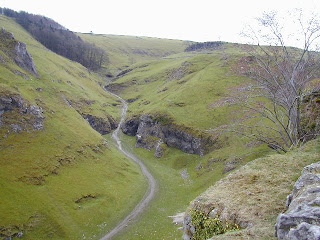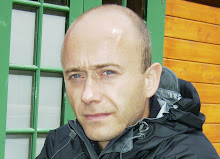Distance: 40.97 miles (advertised 40 miles)Ascent / descent: +4858' / -4766'Terrain: varied (wet grass / fields, hard trail, rocky trail, road)Time: 07:06:32Splits: 10:25 (avg), 7:40 (fastest), 15:58 (slowest)Position: tbcNOTE: all photos have been taken from
http://www.geograph.org.uk/ Elevation profile of HP40
Elevation profile of HP40 Splits for my HP40 race 2008
Splits for my HP40 race 2008The High Peak 40 or HP40. My 4th and final race in the UK Vasque Ultra Championships and a race I've run for the past 3 years, this one included. It contains a fair amount of road running but the road is well broken up by such a variety of other terrain types from lovely lake side paths to fields, to muddy dale tracks and rocky hill top trails, that this race is one of my favourites. It is exceptionally well organised with drinks and food provided at every 1 of 12 checkpoints so you don't need support or to carry much except for a drinks bottle and some weatherproof gear. Although the latter wasn't needed at all on Saturday. Sheesht it was hot.
I didn't get home from work till 7pm on the Friday so it was a quick in, eat, get stuff ready, have beer on couch then off to bed. The alarm went off at 4am and I awoke a bit disoriented with the sound. Porridge quickly eaten, coffee cup and water bottles filled I was out the door in 30 mins for the 2.5 hour drive to Buxton in the Peak District. The M1 was pretty dead but music from Radio 2 kept me going till dawn arose.
The Peak District is not strictly a particularly mountainous terrain but it is lovely, and great running country with lots of ups and downs and a real mixture underfoot. The HP40 starts and ends in Buxton, taking in a 40 mile loop of the Goyt Valley, Rushup Edge, Mam Tor, Cave Dale, Tideswell Dale, Cressbrook and the River Wye and the Deep Dales.
I arrived, found the registration and headed back to my car to get ready. Richie C passed me on his way to registration and said 'hello Brian'. I caught up with him when he returned, wearing his new Skinz (yes very slick), in an attempt to stave off the excesses and damage of the UTMB. Brave fella I thought, this is likely to hurt so soon after. He was well aware of this likelihood. The UTMB sounds like such a race, I can't wait to enter next year. It'll be a challenge like no other.
A chap called Ally (Ali?) came up to me asking if I was Brian McIntosh, to which I responded affirmatively. He had apparently read my Highland Fling race report and been inspired to enter it next year. He was entering the HP40 as his first ultra at a distance slightly below the Fling for preparation. If you are reading this Ally, I hope it all went well - the heat was brutal! It's great that someone has been motivated to run an ultra partially as a consequence of blogging. Spread the ultra love as Dr Marc and Tanya (a pair of american ultra bloggers) would say. Cheesey but true!
I met a girl who had travelled down with Richie called Lucy as well. I think she was Lucy Colquhoun but can't be certain. She shot off like a bolt so I suspect she was. No other family members were about that I saw although Ritchie said George Cairns was there.
Anyway I stretched (something I forgot to do last year - doh) and headed down to the start. Not much hanging about and we were off, Lucy leading the field. 7:15 pace, crikey better slow down I thought as we headed out of the centre of Buxton towards the climb over the moors to the Goyt Valley. I slowed to a more sustainable 8:00 - 8:30 pace until we hit the hill up to the moor when power hiking was the order of the day.
After the moor I slotted in beside a long haired runner from Essex whose name I can't remember, and a chap called Andy from near Whitby who I met both last year and in 2006. We ran together down the steep sloping road to Fernilee reservoir and along its banks, chatting as we went, keeping the pace between 8:30 and 9:00. The sky was clear blue gorgeous and I was already sweating lots. I kept having to eject bogies from my nose, a behaviour which I know winds Miek Mason up, but there's not a lot else to do mid race when there's stuff to come out. I wondered whether I still had some cold virus inside me.
 Fernilee Reservoir in the Goyt Valley
Fernilee Reservoir in the Goyt ValleyI felt strong as we left the Goyt Valley and headed east for Rushup Edge and Mam Tor. I kept up the pace at sub - 9 levels but walked up the steeper or more sustained hills so as not to knacker myself. I was drinking well and despite the bogies and sweat was feeling great. Sub 7 hours looked on - my goal for the race. Upon reaching the Rushup Edge checkpoint I kept up the pace and deliberately grinded out the slow mile or two uphill to Mam Tor, peeling away from Long Haired Essex Man and Andy. The air was beginning to get warm now.
 Mam Tor from the air
Mam Tor from the air Hollins Cross from near Mam Tor
Hollins Cross from near Mam TorThe descent from Mam Tor to Hollins Cross then off the south side of the ridge to Castleton is great fun - very fast with lots of rocks to scrabble and jump down in the latter stages. My legs felt fine despite the pummelling and I got into the Castleton checkpoint on my own. Another runner approached as I finished filling up my water bottle and headed off, jaffa cakes stuffed in mouth. The runner kept with me into Cave Dale but I kept up a good power hike pace in the early stages and upped it to a light jog in the latter, less steep sections and lost him as a consequence.
 Cave Dale viewed from above
Cave Dale viewed from aboveI was alone in the hard limestone fields above Cave Dale when I saw a runner in the distance and thought I'd keep them in sight, or maybe even catch them. Little did I know it would be a suffering Ritchie C. Well, I guess it was only 4 weeks ago that he ran 103 miles with 33,000' ascent in the UTMB so he probably has a good excuse for being caught by me! :-)
We ran together for bit, chatting (good to have met you Ritchie, if you are reading this) but I kept the next checkpoint brief so peeled away. I overtook another runner on the long gradual road descent to Tideswell village and dale the Ritchie overtook me, his second wind emerging. Good stuff. My legs were beginning to feel the pain though as marathon distance approached - I can never be entirely sure if this is psychological or whether there is some damage threshold at ~26 miles that kicks in.
I passed through the Tideswell checkpoint amidst the stink of a small sewage treatment plant with odour issues to be shortly overtaken by the 2nd lady. I kept up with her for the next 5 miles or so at around 9:05 - 9:20 pace, grinding out the miles, ignoring the growing pain and enjoying the scenery in the dales. Lovely, picturesque stuff.
 Near Cressbrook
Near CressbrookRitchie C passed me again, he had gotten lost for the 2nd time so wasn't having his ideal race, but looked cheery nonetheless. No swearing. Maybe he was just being polite.
I had been sweating for hours now and the heat must have been above 20C by now. My t-shirt was covered in salty stains.
I think dehydration was now taking its toll. The climb up the first Deep Dale to the long road section took forever and I just couldn't get more than a plod out of my legs. My stomach felt heavy but I was hot and dripping with sweat. After what seemed like an eternity I reached runnable ground and made myself run up the last half mile to the checkpoint next to the 3 mile long road section from hell. The 3rd lady caught me and another fella up here. Both left before me.
 Looking up Deep Dale number 1
Looking up Deep Dale number 1The road section from hell at mile 33
I drank as much as I could and left stuffing jaffa cakes into my mouth, settling into a plod behind the runners in front. I could feel despondency and an I can't be arsed mood take hold as I looked ahead along the seemingly endless 3 mile road section from hell. Sheesht it was sunny, but at least there was a breeze. After about 1 mile I began to think making sub 7 hours will be tight I'd better get a shift on and so upped the pace from 10:00-10:30 to 9:10 - 9:30 per mile. I overtook the 2 runners plus another but it didn't feel pleasant. Nausea was beginning to make its presence felt.
I kept up the pace and staggered towards the 2nd Deep Dale, a hilariously hidden, 200' odd deep ravine in otherwise flattish limestone farmland. I staggered down one side and up the other but had to let the 2nd lady over take me. Nausea was rising and my head was feeling hot and a bit wobbly. Sweating, sweating.

The chasm of Deep Dale number 2
I topped out of Deep Dale 2 and managed to stagger into a trot across the field to the last checkpoint, sweating. Quickly downing some water I tried rather feebly to run on. After 20m I managed to get into some sort of rhythm and forced myself to keep up a pace. Making sub 7 hours was going to be tight. I forced on, nausea rising and head feeling hot, sweaty and wobbly. Come on Brian, push it, push it, I ran up the last grassy field and had to stop at the top for a second or two, holding on to a fence. Push it, I ran on. Well, tried to run on.
I kept up some sort of run as I entered Buxton but I knew sub 7 was out of my grasp. Well, keep your position then I told myself, glancing back to see another runner a few hundred metres behind. I pushed on, sweating and feeling really not very right at all, holding the other runner at bay until I could stop when I reached the line and fall onto the crash mats provided. My legs ached, my shirt was caked in salt, my legs in mud and my head a bright sunny red. My thoughts swam and it took me good 5 minutes before I could sit back up again. That was a tough race. Superbly organised, extremely hot and wonderfully varied. I'll be back in 2009, potentially with UTMB legs like Ritchie C. :-)




















.jpg)









